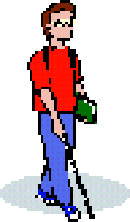 October 15, 1970 was declared International White Cane Safety
Day for the first time by the President of the International Federation of
the Blind. This date was adopted at the first quinquennial convention of
the IFB, held in Colombo on October 4, 1969. The object of the exercise is
to stimulate the general public to a better understanding of blindness and
visual handicap, and to make people more aware of the white cane as a
mobility aid. October 15, 1970 was declared International White Cane Safety
Day for the first time by the President of the International Federation of
the Blind. This date was adopted at the first quinquennial convention of
the IFB, held in Colombo on October 4, 1969. The object of the exercise is
to stimulate the general public to a better understanding of blindness and
visual handicap, and to make people more aware of the white cane as a
mobility aid.
Peguilly d'Herbemont was born on 25th June 1888 into an old French
noble family of the same name. In her youth she led the conventional and
protected existence, devoid of great activity, of a girl from a "good
family", an existence reminiscent of the life of the aristocracy before
the French Revolution. She never visited a public school, but was educated
by German and English governesses and convent sisters. Her movements were
restricted and were mainly confined to the family positions in Paris and
Belgium, but she spent most of her time at the castle of Charmois not far
from Verdun.
In the process of helping individual blind people across the road,
Mademoiselle d'Herbemont was made aware by narrow scrapes which almost led
to accidents, of the precarious situation of the visually impaired brought
about by the steadily increasing traffic on the roads. She first spoke
about measures to protect the blind against street hazards to her mother
in 1930, but she was of the opinion that it was unfit for a lady of good
society to create a public outcry and advised her to stick to the
transcription of books, a popular pastime of ladies of rank at the
time.
But the idea did not leave her. The urgent wish to encourage the
integration of the blind into society by providing them with a means of
moving about more freely without endangering others, and at the same time
attracting the attention of passers-by ready to offer assistance, caused
her to take the, unusual step of writing to the editor of the Paris daily
"Echo de Paris" in which she suggested issuing the blind of the Paris
region with white sticks similar to those used by the traffic police.
The editor took up the idea, published it in November 1930 and saw to
it that the relevant authorities acted with atypical speed. Thus it was
that the white cane received official backing, and on 7th February 1931
|